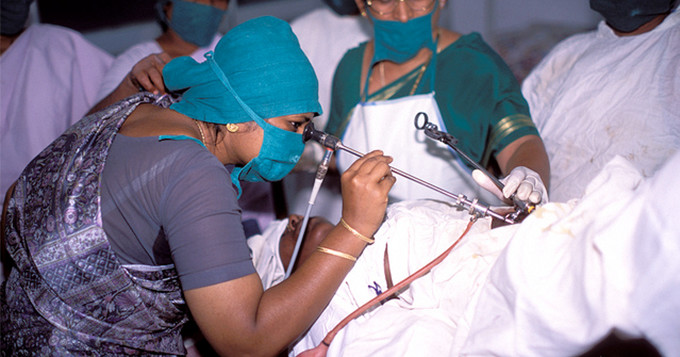
Altmetric’s High Five – Big News for Human Health. Bad News for Cheetahs (December 2016)
Welcome to the Altmetric High Five in association with the Science Council. On a monthly basis, the High Five posts examine a selection of the most popular research outputs Altmetric has seen attention for that month.
The original post can be found on the Altmetric blog. Links to all papers included can be found in the Reference section at the end.
1. An Ebola vaccine

Ebola virus. Image credit: CDC
Our first High Five paper for December 2016 is “Efficacy and effectiveness of an rVSV-vectored vaccine in preventing Ebola virus disease,” published in The Lancet. The study reports on results of a trial of an Ebola vaccine produced by Merck, rVSV-ZEBOV.
Nearly 300 news outlets covered the study, which was also highly tweeted.
2. A woman’s touch

Doctor at hospital performing operation on woman. India. Image credit: John Isaac / World Bank
Our second High Five paper is “Comparison of Hospital Mortality and Readmission Rates for Medicare Patients Treated by Male vs Female Physician,” published in JAMA in December 2016. The study authors examined “nationally representative data of hospitalized Medicare beneficiaries” and found that patients treated by female physicians had significantly lower mortality rates and hospital readmission rates compared with patients treated by male physicians in the same hospital.
Nearly 200 news outlets covered the study.
3. Changes in brain structure for pregnant women

Image credit: Ken Hammond (USDA)
Our next High Five paper is “Pregnancy leads to long-lasting changes in human brain structure” published in Nature Neuroscience. The study authors examined changes in brain structure pre- and post- pregnancy in first-time mothers and fathers. They found that “pregnancy confers long-lasting changes in a woman’s brain.”
Over 250 news outlets covered the study.
4. A handful of nuts a day…

Image credit: Sage Ross, Wikimedia
Our next High Five paper is “Nut consumption and risk of cardiovascular disease, total cancer, all-cause and cause-specific mortality: a systematic review” published in BMC Medicine. In an analysis of 20 different studies, researchers found that “[h]igher nut intake is associated with reduced risk of cardiovascular disease, total cancer and all-cause mortality, and mortality from respiratory disease, diabetes, and infections.”
Nearly 200 news outlets covered this study.
5. Endangered cheetah

Image credit: Joachim Huber, Wikimedia
Our final High Five paper for December 2016 veers away from our human health theme.
“The global decline of cheetah Acinonyx jubatus and what it means for conservation” was published in PNAS on December 27, 2016. The study shows “dramatic declines of cheetah across its distributional range.”
Over 200 news outlets covered the study. Many of these called for greater conservation awareness and action for cheetah. As a result of the study, experts are calling for cheetah to be listed as “Endangered” rather than “Vulnerable” on the IUCN Red List.
References:
- Efficacy and effectiveness of an rVSV-vectored vaccine in preventing Ebola virus disease
- Comparison of Hospital Mortality and Readmission Rates for Medicare Patients Treated by Male vs Female Physician
- Pregnancy leads to long-lasting changes in human brain structure
- Nut consumption and risk of cardiovascular disease, total cancer, all-cause and cause-specific mortality: a systematic review
- The global decline of cheetah Acinonyx jubatus and what it means for conservation
